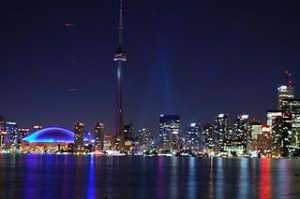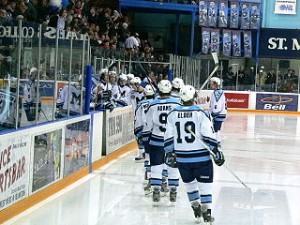When it comes to spectator sports, Toronto might just be Canada’s first post-hockey town.
The Maple Leafs have an absurd 20-year waiting list for season tickets, and they are the financial darlings of the NHL, with a league-high value of 505 million dollars (US), as estimated by Forbes.com in December 2010.
But, as the late Hall-of-Fame-writer Jim Kelley once suggested, perhaps nothing grows in the shadow of the Leafs.

Consider the 2011 edition of the Memorial Cup. The Mississauga St. Michael’s Majors beat out three other OHL applicants, in a hotly contested selection process, to bring Canada’s prestigious junior hockey championship to the Greater Toronto Area (GTA) for the first time since the Oshawa Generals hosted the tournament in 1987.
To the league’s credit, the primary consideration for a potential Memorial Cup host is the projected quality of the team, according to OHL commissioner and CHL president David Branch. This makes good hockey sense, but it isn’t the only factor for the decision, and some have suggested that the Majors didn’t deserve the honour based on their history of dismal attendance.
The Memorial Cup is a huge tournament unto itself now and, yeah, you’ll get people coming from all over the country to watch it, but are you going to garner support for Mississauga after the fact? I highly doubt it.” Barrie Colts co-owner Jim Payetta
According to the Globe and Mail, the Majors finished second last in average OHL attendance in 2009-10, despite posting a 90-point season, with an average attendance of 2 250 per game – besting only the Brampton Battalion, yet another struggling GTA franchise.
The Majors’ lack of support leading up to their bid was all the more disheartening considering that the historic franchise has already relocated since re-entering the OHL in 1996. The Majors abandoned downtown Toronto for suburban Mississauga in a strange revolving door scenario in 2006 that also had the OHL’s Ice Dogs abandon Mississauga and the GTA altogether to re-establish themselves in St. Catherine’s.
Some wondered aloud if the high-profile tournament was intended to improve the Majors’ future performance at the turnstile.
Immediately after the 2011 Memorial Cup announcement, Barrie Colts co-owner Jim Payetta was doubtful about any attempt to increase support for the Majors. “The Memorial Cup is a huge tournament unto itself now and, yeah, you’ll get people coming from all over the country to watch it, but are you going to garner support for Mississauga after the fact? I highly doubt it.”
While Payetta’s Colts were a disappointed candidate for last year’s Memorial Cup, he put his finger on a problem that is larger than the Majors – trying to sell hockey tickets in Toronto.
While the Maple Leafs are perennial sell-outs, despite their often disappointing results, they represent the sole spectator-hockey success in the metropolis.
The Maple Leafs’ farm team, the Toronto Marlies of the American Hockey League (AHL), drew an average of 4 694 fans per match in 2010-11, placing the franchise in the bottom half of the league in terms of attendance, and 13% percent below the AHL average. This in a league that includes franchises in non-traditional hockey markets like Houston, San Antonio, and Peoria (Arizona) – all of whom boasted healthier gates than Toronto in 2010-11.
After five home games in 2011-12, the Marlies have an average attendance of 3 120 – an embarrassing placing of 28th in the 30-team league.
Perhaps the Marlies have their namesake to blame. The famous Toronto Marlboros were a popular major junior hockey club that maintained close relations with the Maple Leafs for over 60 years, sending dozens upon dozens of players to the NHL. But the franchise was forced to abandoned Toronto after the 1988-89 season, moving to Hamilton before moving again to Guelph where the team finally found financial stability.
For those readers not familiar with Canadian geography, this is akin to New York City initially losing a famous sports team to Newark, before it finally settles down in Rochester.
In 1937 the forerunner league to the OHL consisted of seven teams – six of which were based in Toronto – including the Marlboros and the original St. Michael’s Majors, while the Oshawa Generals rounded out the league as the only ‘non-Toronto’ squad
While the demographics of Ontario have changed since the 1930s, Toronto remains the population centre of the province with 2.5 million in the city proper, and an estimated 4.5 million in the GTA. Yet, with the exception of the peripheral Oshawa Generals, non-NHL spectator hockey doesn’t seem to resonate with Canada’s largest population city anymore.
Inevitably, when discussing sports franchises and Toronto, the issue of competition for entertainment dollars is raised. Major League Baseball’s Blue Jays, and the Canadian Football League’s Argonauts certainly have their own struggles. There is no question that there are far more options for your entertainment budget in Toronto than in Owen Sound. However, the fact remains that hockey is supposedly Canada’s sport, and Toronto is Canada’s largest city.
Is non-NHL spectator hockey simply a small-town phenomenon?
We know it’s a Leaf town, we just don’t know if it’s a hockey town.” OHL Commissioner David Branch on the city of Toronto
Toronto is not the only major Canadian city with multiple tiers of spectator hockey. For example, the cities of Vancouver, Calgary, Edmonton, and Ottawa all boast NHL squads but are also home to major junior hockey franchises. Vancouver, Calgary, and Ottawa are among their leagues’ best-drawing teams, while Edmonton is newer franchise that represent average attendance numbers for their respective leagues. Montreal’s major junior franchise just left town, but not due to attendance troubles. The Montreal juniors were ninth of 18 teams when it came to attendance in the Quebec Major Junior Hockey League last year.
So Toronto’s junior hockey woes would appear to be unique amongst large cities in Canada.
Meanwhile, Chicago proves that AHL hockey can work in an NHL market. In 2010-11, the Chicago Wolves had an average attendance of 7 453, which was good enough for the third-best in the 30-team AHL.

Returning to the Majors, it must be pointed out that their average attendance for the 2010-11 season rose by a remarkable 35% to just over 3 000 folks per game, according to the attendance-tracking website MIB.org, but that still only put the Majors in 12th position in the 20-team OHL.
The only game of the 2011 Memorial Cup to sell out was the final, which the Majors lost by a score of 3-1 to the Saint John Sea Dogs.
With six home games of the 2011-12 season in the books for the Majors, they are averaging 2 133 fans per contest – third last in the league. So Payetta’s prediction seems correct.
Shortly after the Memorial Cup announcement in May of 2010, Branch was interviewed on Sportsnet The Fan 590 radio, and when asked about viability of the championship tournament returning to the GTA, he stated, “we know it’s a Leaf town, we just don’t know if it’s a hockey town.”
But what we do know is that there is a mounting body of evidence that suggests that unless you’re the Maple Leafs, Torontonians just aren’t that interested in paying to watch you chase a puck.
Is something wrong with Toronto hockey fans?
It’s really too bad Toronto\Mississauga doesn’t care about this team. They really don’t know what they’re missing. The Majors have been a superior team to the Toronto Maple Leafs for years, but as it’s been said before: Tor\Miss. is a Leaf town. It doesn’t make sense. For what it costs to go to one Leaf game, one could get season tix for the Majors. The Majors have a gorgeous building that is the envy of many of the OHL’s teams, but in the GTA, it’s Toronto Maple Laughs or nothing.
You hit the nail on the head in that article, it’s a Leafs town not a hockey town. The Marlies attendance is pathetic and you’d think people who can’t get Leafs tickets would want to see future Leafs, unfortunately not the case.